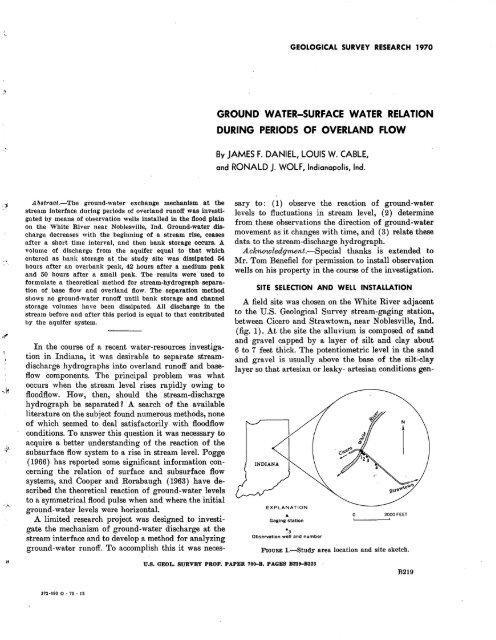RESEARCH· ·1970·
RESEARCH· ·1970·
RESEARCH· ·1970·
Create successful ePaper yourself
Turn your PDF publications into a flip-book with our unique Google optimized e-Paper software.
GEOLOGICAL SURVEY RESEARCH 1970<br />
GROUND WATER-SURFACE WATE'R RELATION<br />
DURING PERIODS OF OVERLAND FLOW<br />
By JAMES F. DANIEL; LOUIS W. CABLE,<br />
and RONALD j. WOLF, Indianapolis, Ind.<br />
Abst·raot.-The ground-water exchange mechanism at the<br />
stream interface during periods of overland runoff was investigated<br />
by means of obse.rvation wells installed in the :flood plain<br />
on the White River near Noblesville, Ind. Ground-water discharge<br />
decreases with the beginning of a stream rise, ceases<br />
nfter n short time interval, and then bank storage occurs. A<br />
volume of discharge from the aquifer equal to that which<br />
entered as bank storage at the study site was dissipated 54<br />
hours after an overbank peak, 42 hours after a medium peak<br />
and 50 hours after a small peak. The results were used to<br />
formulate a theoretical method for stream-hydrograph separation<br />
of base flow and overland flow. The separation method<br />
shows no ground-water runoff until bank storage and channel<br />
storage volumes have been dissipated. All discharge in the<br />
stream before and after this period is equal to that contributed<br />
hy the aquifer system.<br />
In the course of a recent water-resources investigation<br />
in Indiana, it was desirable to separate streamdischarge<br />
hydrogra phs into overland runoff and baseflow<br />
components. The principal problem was what<br />
occurs when the stream level rises rapidly owing to<br />
floodflow. flow, then, should the stream-discharge<br />
hydrograph be separated~ A search of the available<br />
literature on the subject found numerous methods, none<br />
of which seemed to deal satisfactorily with floodflow<br />
conditions. To answer this question it was necessary to<br />
acquire a better understanding of the reaction of the<br />
subsurface flow system to a rise in stream level. Pogge<br />
( 1966) has reported some significant information concerning<br />
the relation of surface and subsurface flow<br />
systems, and. Cooper and Rorabaugh (1963) have described<br />
the theoretical reaction of ground-water levels<br />
to a symmetrical flood pu~se when and where the initial<br />
ground-water levels were horizontal.<br />
A limited research project was designed to investigate<br />
the mechanism of ground-water discharge at the<br />
stream interface and to develop a method for analyzing<br />
ground-water runoff. To accomplish this it was necessary<br />
to: (1) observe the reaction of ground-w:ater<br />
levels to fluctuations in stream level, (2) determine<br />
from these observations the direction of ground-water<br />
movement as it changes with time, and ( 3) relate these<br />
data to the stream-discharge hydrograph.<br />
Acknowledgment.-Special thanks is extended to<br />
1\ir. Tom Benefiel for permission to install observation<br />
wells on his property in the course of the investigation.<br />
SITE SELECTION A!ND WELL rNSTALLATION<br />
A field site was chosen on the White River adjacent<br />
to the U.S. Geological Survey stream-gaging station,<br />
between Cicero and Strawtown, near Noblesville, Ind.<br />
(fig. 1). At the site the alluvium is composed of sand<br />
and gravel capped by a layer of silt and clay about<br />
6 to 7 feet thick. The potentiometric level in the sand<br />
and gravel is usually above the base of the silt-clay<br />
layer so that artesian or leaky- artesian conditions gen-<br />
•<br />
Gaging station<br />
.3<br />
Observation well and number<br />
0 2000 FEET<br />
FIGURE 1.----Study area location and site sketch.<br />
U.S. GEOL. SURVEY PROF. PAPER 70G-B, PAGES B99-B223 ·<br />
B219<br />
372-490 0- 70- 15
















